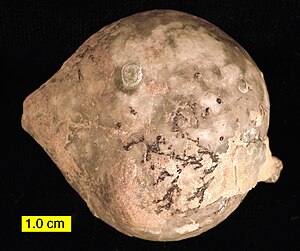| CystoideaTemporal range: Middle Ordovician–Devonian PreꞒ Ꞓ O S D C P T J K Pg N | |
|---|---|

| |
| "Cystoidea" from Ernst Haeckel's Kunstformen der Natur, 1904 | |
| Scientific classification | |
| Domain: | Eukaryota |
| Kingdom: | Animalia |
| Phylum: | Echinodermata |
| Subphylum: | †Blastozoa |
| Informal group: | †Cystoidea von Buch 1846 |
| Subdivisions | |
| |
Cystoidea was defined as a class of extinct paleozoic blastozoan echinoderms established to encompass stalked taxa that were neither crinoids nor blastoids. It was shown to be polyphyletic in the late 1960s but continues to be used even in recent (as of 2022) literature to discuss both rhombiferans and diploporitans.
History
The concept of Cystoidea has a complex history, with many emendations from its original conception. Early versions included the homalozoans, eocrinoids, paracrinoids, blastoids, and edrioblastoids. By 1967 the modern usage encompassing only rhombiferans and diploporitans had been established, although questions remained regarding the possible inclusion of blastoids. Despite these removals, speculation continued as to whether cystoids were ancestral to blastoids, crinoids, or echinoids.
Work published in 1967 and 1968 questioned whether Cystoidea formed a natural group, and in 1972 the former orders Rhombifera and Diploporita were elevated to class rank and Cystoidea was no longer used as a formal taxon. As an informal group, it encompasses those two former orders (which are no longer thought to be monophyletic either), but not the Blastoidea.
Description
Cystoids have a theca featuring many plates, with distinctive pores. These pores are central to the identification of cystoids, and either sit on one plate (in diploporitans) or are shared by adjacent plates (in rhombiferans). These pores have a respiratory function.
The shape of the theca itself varies dramatically in shape, with some forms described as "rather bizarre." Some cystoids lost their stems as adults, or possibly do not have stems at all.

It is encrusted by a graptolite (black branches).

See also
References
- ^ Sheffield et al. 2022, p. 30
- Kesling 1967, p. S151–S152, S167
- Kesling 1967, p. S86
- Kesling 1967, p. S88
- Kesling 1967, p. S98
- Kesling 1967, p. S109
Works cited
- Sheffield, Sarah L.; Limbeck, Maggie R.; Bauer, Jennifer E.; Hill, Stephen A.; Nohejlová, Martina (2022). ""Cystoidea"". In Sumrall, Colin D. (ed.). A Review of Blastozoan Respiratory Structures. Elements of Paleontology. Cambridge University Press. doi:10.1017/9781108881821. ISBN 9781108794725.
- Kesling, Robert V. (1967). "Cystoids". In Moore, Raymond C. (ed.). Treatise on Invertebrate Paleontology, Part S: Echinodermata 1. Vol. 1. University of Kansas Press. pp. S85 – S267. Retrieved 29 October 2024.
| Taxon identifiers | |
|---|---|
| Cystoidea |
|
This prehistoric echinoderm-related article is a stub. You can help Misplaced Pages by expanding it. |